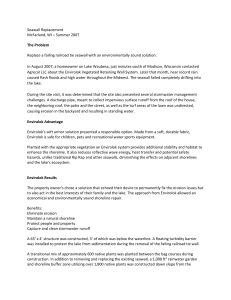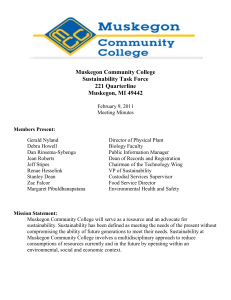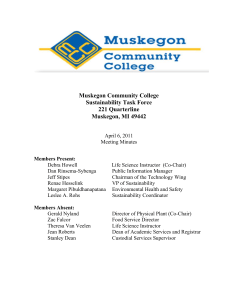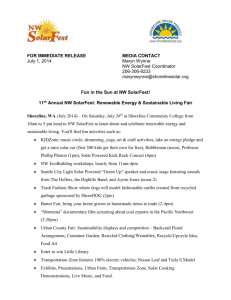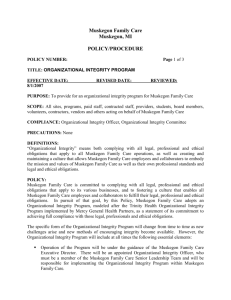The Accretion of the Past: Research and Outreach on the Muskegon
advertisement
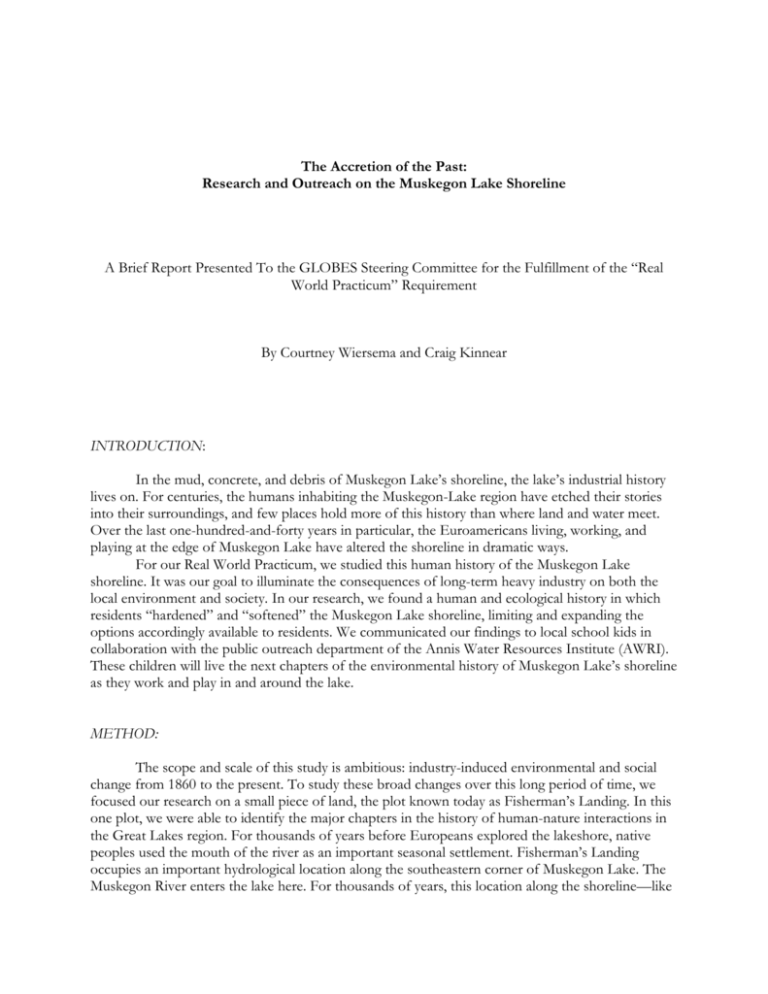
The Accretion of the Past: Research and Outreach on the Muskegon Lake Shoreline A Brief Report Presented To the GLOBES Steering Committee for the Fulfillment of the “Real World Practicum” Requirement By Courtney Wiersema and Craig Kinnear INTRODUCTION: In the mud, concrete, and debris of Muskegon Lake’s shoreline, the lake’s industrial history lives on. For centuries, the humans inhabiting the Muskegon-Lake region have etched their stories into their surroundings, and few places hold more of this history than where land and water meet. Over the last one-hundred-and-forty years in particular, the Euroamericans living, working, and playing at the edge of Muskegon Lake have altered the shoreline in dramatic ways. For our Real World Practicum, we studied this human history of the Muskegon Lake shoreline. It was our goal to illuminate the consequences of long-term heavy industry on both the local environment and society. In our research, we found a human and ecological history in which residents “hardened” and “softened” the Muskegon Lake shoreline, limiting and expanding the options accordingly available to residents. We communicated our findings to local school kids in collaboration with the public outreach department of the Annis Water Resources Institute (AWRI). These children will live the next chapters of the environmental history of Muskegon Lake’s shoreline as they work and play in and around the lake. METHOD: The scope and scale of this study is ambitious: industry-induced environmental and social change from 1860 to the present. To study these broad changes over this long period of time, we focused our research on a small piece of land, the plot known today as Fisherman’s Landing. In this one plot, we were able to identify the major chapters in the history of human-nature interactions in the Great Lakes region. For thousands of years before Europeans explored the lakeshore, native peoples used the mouth of the river as an important seasonal settlement. Fisherman’s Landing occupies an important hydrological location along the southeastern corner of Muskegon Lake. The Muskegon River enters the lake here. For thousands of years, this location along the shoreline—like countless others like it in the region—has attracted people, providing food, facilitating travel, and offering a convenient location for settlement. That settlement became a trading and communications hub during the fur trade. From the 1860s to 1900, this spot was quite literally the focal point of Muskegon’s world-class lumber industry. The Muskegon Lake Boom Company corralled the millions of logs that came down the river on the spring current into floating pens at this location, from which the logs were sorted and distributed to the dozens of sawmills along the lake’s southern shore. During the early-twentieth century, the area had become so choked by sawdust and debris that residents used it as an unofficial trash dump. During the middle of the twentieth century, this spot, wrecked and abandoned like countless other industrial shorelines in the Midwest, was reclaimed by the city. In recent years, the City of Muskegon, like many mid-sized cities hoping to revive their post-industrial economies with tourism, sold the land to a company that turned it into a recreational area: Fisherman’s Landing. This one spot has played a significant social role during every era of the lake’s human history. We investigated the history of both the human society and the shore-zone ecosystem of this location. As such, we turned to both historical and ecological evidence. The Annis Water Resources Institute, a Grand Valley State research and outreach organization, assisted us in both the ecological aspects of our research and the public education we incorporated into our RWP (see below). Similarly, the Muskegon County Historical Society houses a variety of historical sources spanning the area’s history from Euroamerican settlement to the present. During our research, the Historical Society shared newspapers, plat maps, local directories, and lumber company records documenting the uses of Muskegon Lake’s southern shoreline, including the Muskegon Lake Boom Company, over the last one-hundred-fifty years. For a more detailed portrait of the land-use history of this location over time, we turned to a third archival source: public tax records. Between the records held by the Muskegon County Historical Society and the public records on file at the Muskegon County Clerk’s Office, we reconstructed the ownership history of this plot from the 1870s to the present. With both kinds of evidence—ecological and historical—we constructed the human-ecological history of this place on Muskegon Lake’s shore. FINDINGS: The history of the Muskegon Lake shoreline is a story of how inhabitants built up and then broke back down the shoreline. Ecologists call this the “hardening” and “softening” of the shoreline. Before the industrial era, Fisherman’s Landing was a place of confluences. River met lake; lake met shore; water met air. Yet these confluences were “soft,” or gradual. The Muskegon River slowed, seeping into a marshy plain at its mouth. The river’s south channel was little more than a soft current running through the grass. Over time, Euroamericans hardened the shoreline for industrial use, creating more defined boundaries between land and water. The Muskegon Boom Company (MBC) offered the first major example of this kind of shoreline hardening. During the late-nineteenth century, the MBC operated in the exact location of present-day Fisherman’s Landing. Mind you, these were the booms themselves. “Booms” were a chain of logs, floating atop the water, to serve as pens for sorting and distributing the millions of logs that flowed into the lake. In the 1870s, 1880s, and 1890s, these booms floated on what is now dry land. How did this happen? As millions of logs ran down the Muskegon River, they tore up the river bed and the marsh at the mouth of the river, uprooting the aquatic plant life on the river and lake beds. Gravity’s potential energy became the kinetic energy that pulled the river’s water down to the lake. Without obstacles to absorb any of that kinetic energy, the river had more speed and energy to carry debris than before. The river carried sand, pebbles, organic detritus, and even microinvertebrates to the log-cleared mouth of the river. But the current slowed as the river filled the larger volume of the lake, and most of the material swept along to the lakebed dropped out of the current—right at the MBC’s floating log pens. Between 1860 and 1900, material from upriver accumulated at the mouth of the river. When combined with the sawdust dumped into the lake by the sawmills lining the southern lakeshore, new land literally emerged the water. Maps between 1877 and 1900 depict the accretion of new solid ground around the Muskegon Boom Company’s pens. As impressive as the emergence of land from water might be, the transformation of the shoreline during the twentieth century might be even more stark. The lumber industry in Muskegon collapsed after 1900, but other industries quickly took advantage of the existing industrial infrastructure along the lakeshore. The new land that had accumulated where log booms used to float became prime shoreline real estate, and a series of companies took advantage of another confluence at this location: the connection of lake and railroad. In the Spring of 1914, the Muskegon Chronicle lamented a particular kind of accretion where the lake and river met: “A stagnant pool of water, weed-chocked and filled with rubbish, is all that is left of the once splendid mouth of the Muskegon River through which the water roared a generation ago, and on whose turbid floods the bulk of the millions of feet of logs cut here during the lumber era were borne,” (quotes in Carlson, Muskegon Chronicle, 2 April 2000). One of the most significant landholders during the early twentieth century was a chemical-production company that shored up the spongy, sawdust-laden land with concrete. Today, efforts by AWRI and others are softening Muskegon Lake’s shoreline. This is both a physical change—they are literally breaking up the concrete for ecological restoration projects—and metaphorical. The city is seeing a shift whereby the barriers preventing residents from accessing the formerly private and industrial shoreline property are giving way and to tourism and broader public access. The plot of land we studied, for example, sat abandoned, industrialized and polluted, for a few decades before it was reclaimed by city, who then sold the land to the developers who created Fisherman’s Landing. In short, this one spot embodies the larger history of Midwestern shorelines and waterways, from its long history of native use to its industrialization, hardening, and limited access to the more recent efforts at softening, restoring, opening the shoreline to more people who live, work, and play near the lake. APPLICATIONS: If understanding the ways in which human and ecological history have been intertwined is a Real-World problem worth investigating, then communicating that history and its lessons is another, even more challenging Real-World problem. We made it a central goal of our RWP to produce usable knowledge—information, stories, and lessons accessible beyond the academy, especially those who have a stake in the future of this place. To do this, we drew from concepts in cultural studies and communication theory. We adapted the ecological concepts of “accretion” and “hardened and softened” shorelines to serve as metaphors to convey the environmental history of the Muskegon Lake shoreline simply and clearly to non-specialists. “Accretion” communicates the way in which human history builds up in a tangible, material way over time. Muskegon’s history remains in its shoreline, influencing how residents might use the land in the future. “Hardened” and “softened” shorelines suggest the shoreline’s possibilities: historically, a softer shoreline has offered its human inhabitants more options than the more hardened ones. Together, these concepts convey what’s at stake for residents interested in the Muskegon Lakeshore: today’s decisions are not only limited by the “accretion” of the past, but these decisions also will “harden” or “soften” the choices available in the future. We communicated our findings directly to these stakeholders. We created a (Common-Core compliant) lesson plan for middle and/or high school students that emphasized both the “accretion” of the lake’s industrial past and the “hardening and softening” of possibilities for the shoreline. Our lesson introduces students to the eras of use of Fisherman’s Landing, asks them to make connections to this history’s effects on the lakeshore and Muskegon society, and then contemplate its implications for similar patterns across the Great Lakes region. This format challenged us to translate what we know to a decidedly non-specialist audience, especially the students living and growing up in this place who likely will live with the legacies of the shoreline’s accreted past and the consequences of any future hardening or softening of the shoreline. We taught our lesson at two venues. First, we took it directly to the Muskegon community, where we spent a day interacting with those who live their lives in (or near) our research area. On May 29, 2014 volunteered with the Annis Water Resources Institute (AWRI), a Grand Valley State University research station in Muskegon. The institute coordinates the research of a team of Great Lakes aquatic ecologists. AWRI exemplifies the kind of researcher-community collaboration that will be necessary for aquatic conservation throughout the region, across the country, and around the world in the coming decades. We volunteered in the outreach branch to work with a group of elementary school children. Under curriculum designed by Dr. Janet Vale for AWRI, these children enjoyed a day of learning about the Muskegon River watershed through activities in the AWRI’s outreach classroom and by conducting real data collection on the institute’s research boat. What made our lesson dovetail so well with the AWRI’s outreach was the way in which Dr. Vale tied their lessons and activities together with environmental histories. For instance, the AWRI outreach instructors emphasized the ways in which the flow of streams and rivers into Muskegon Lake accumulated debris, fertilizers, and toxins over time. We explained to children what a watershed was and how it worked by narrating the Muskegon watershed’s industrial past. That afternoon, on the AWRI’s boat, the children were shown sites along the shoreline where significant industrial institutions operated during various historical eras, referring back to our historical lesson that we provided that morning. We gave our lesson plan a second life in a more academic venue. We are currently elaborating upon and annotating our lesson plan to submit it for publication in The History Teacher, a widely respected, peer-reviewed pedagogical journal for instructors teaching history at all levels. If published in this journal, our lesson has the potential to have an even more significant affect on realworld social debates over ecologically sensitive, industrialized environments. Other teachers can easily adapted the lesson and our “accretion” and “hardening and softening” concepts to teach similar issues in their own regions, which gives the lesson the potential to reach many more people than we could ever encounter on our own. CONCLUSIONS: As this report demonstrates, we have (1) conducted interdisciplinary academic research on (2) a real-world environmental issue and (3) disseminated our findings to both academic and public audiences. We believe that this synthesis of history and ecology on a pressing environmental problem is broadly accessible and, we hope, is useful to those who have the most at stake for this issue: the residents of Muskegon, Michigan. We submit this summary of our collaborative research, outreach, and publication goals as criteria that fulfills our requirements for the GLOBES Real-World Practicum. Sincerely, _________________________ AND _________________________ Courtney Wiersema Craig Kinnear GLOBES Fellow | NSF-IGERT Trainee Ph.D. Candidate Department of History University of Notre Dame GLOBES Fellow | NSF-IGERT Trainee Ph.D. Candidate Department of History University of Notre Dame

